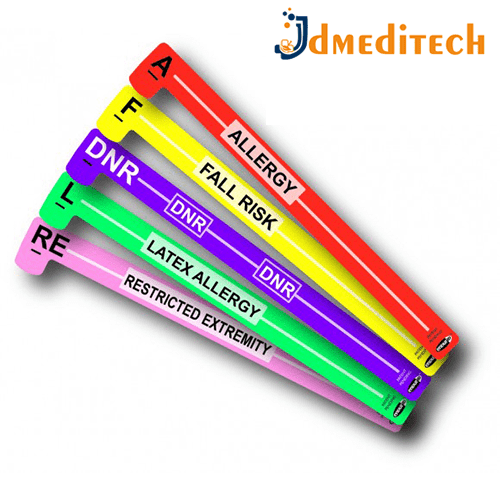The Rising Need for State-of-the-Art Patient Identification Bands in Modern Healthcare Facilities
Exploring the Numerous Types of Patient Identification Band Utilized in Clinical Facilities
In the complex globe of healthcare, the important role of Patient Identification bands commonly goes unnoticed. These bands, differing from simple paper wristbands to sophisticated RFID bands, create the backbone of Patient safety and security protocols, making certain precision in Patient Identification.
Understanding the Value of Patient Identification Bands
While they might seem like mere accessories, Patient Identification bands play a crucial duty in medical facilities. These bands serve as an essential device for validating Patient identity, avoiding medical errors connected to misidentification. Patient Identification bands additionally help in improving management tasks, making sure accurate record-keeping and billing.
Typical Paper Wristbands: Their Usage and Limitations
Traditional paper wristbands have actually been a staple in Patient Identification throughout numerous clinical facilities. While their use prevails, they nurture specific limitations that might affect their effectiveness in Patient administration. This section will concentrate on the extent of their application and the integral downsides connected with their usage.
Paper Wristbands: Usage Scope
In the realm of Patient Identification, paper wristbands have long held a critical duty. These bands are generally made use of in outpatient settings, where the Patient's remain is temporary. The wristbands have necessary info such as the Patient's name, date of birth, and a distinct Identification number. This basic, yet efficient system, permits doctor to quickly and precisely identify patients, ensuring the right therapy is provided. Paper wristbands are additionally utilized in emergency circumstances, where rapid Identification is paramount. Their usage includes occasions like blood contribution drives and mass vaccination programs, better highlighting their flexibility. Despite innovations in technology, the modest paper wristband remains a cost-efficient and reputable solution for Patient Identification in various healthcare situations.
Limitations of Paper Wristbands
In spite of their prevalent use, paper wristbands are not without their drawbacks. In addition, paper wristbands frequently lack the technological capacities of more modern alternatives, such as barcoding or RFID chips, restricting their capability to just showing composed info. Paper wristbands can cause discomfort or skin irritability to some people, especially when worn for extended periods.
Barcoded Wristbands: Improvements in Patient Identification
While Patient Identification has actually long been a crucial element of medical care, the arrival of barcoded wristbands symbolizes a significant jump onward. These bands take advantage of the simpleness of barcoding innovation, permitting for Patient info to be promptly scanned and accessed. They enhance the speed and accuracy of Patient Identification, reducing the risk of clinical errors related to misidentification.
Superhigh Frequency Identification (RFID) Bands: an Action In The Direction Of Futuristic Healthcare
The evolution of Patient Identification bands has actually caused the introduction of Superhigh frequency Identification (RFID) Bands (patient identification band). These innovative tools existing crucial advantages for healthcare centers, using a much more efficient and highly progressed ways of Patient Identification. The application of RFID in healthcare is a significant action in the direction of a much more advanced technique to Patient management and safety
Recognizing RFID Bands

RFID Bands: Key Benefits
Primarily, these bands enhance Patient security by providing precise, rapid Identification, consequently reducing medical errors. RFID bands can save a huge quantity of Patient data, consisting of clinical background and allergic reactions, allowing individualized care. Continued In general, RFID bands stand for a significant improvement in Patient Identification modern technology, benefiting both clients and medical care companies.
Applying RFID in Healthcare
These bands provide a seamless way to track and determine people, ensuring their security and boosting performance in treatment procedures. RFID bands reduce clinical mistakes by offering exact Patient Identification, which is essential in protecting against misdiagnosis or wrong medicine administration. Therefore, the implementation of RFID bands is a considerable action towards enhancing Patient security and medical care delivery.

Color-Coded Wristbands: Helping in Quick and Accurate Medical Diagnosis
In the dynamic environment of a clinical center, color-coded wristbands have actually emerged as essential tools for swift and specific Identification of a person's medical problem. These wristbands, worn by people, bring specific shades that match to different medical problems or statuses. This system is created to offer instant aesthetic hints to medical care suppliers, boosting Patient security and care top quality.
Techniques for Reliable Implementation and Monitoring of Patient ID Bands
Attaining ideal use of Patient Identification bands demands a well-structured method for their implementation and monitoring. Patient education and learning is likewise crucial; people should recognize the function of the bands and the demand for their continuous wear. It's important to have a back-up plan in location, such as barcode scanning or biometrics, to ensure that Patient Identification is never ever jeopardized.
Final thought
Patient Identification bands are crucial in clinical facilities to guarantee safety and accuracy. Typical paper, barcoded, RFID, and color-coded wristbands each hold special advantages, varying from cost-effectiveness to innovative information storage space and immediate clinical signals. Reliable application and administration of these bands can considerably decrease clinical errors, enhance effectiveness, and improve total Patient treatment. Thus, understanding and making use of these Identification tools is vital for maintaining high criteria in healthcare.
These bands, varying from simple paper wristbands to innovative RFID bands, create the foundation of Patient safety protocols, making certain accuracy in Patient Identification.The evolution of Patient Identification bands has brought check this concerning the development of Radio Frequency Identification (RFID) Bands. In general, RFID bands represent a substantial improvement in Patient Identification technology, profiting both you can look here clients and healthcare carriers.
RFID bands decrease clinical mistakes by giving accurate Patient Identification, which is vital in preventing misdiagnosis or incorrect medicine administration. Patient education and learning is additionally vital; clients need to understand the purpose of the bands and the need for their consistent wear.